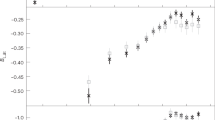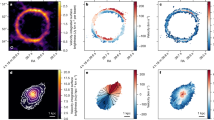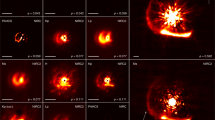Abstract
ALTHOUGH every star passes through a pre-main sequence stage during its formation, only a few astronomical objects have been considered as likely candidates for the early protostellar evolutionary stage1. The bulk of the energy observed as radiation emitted by a compact source in the near IR, from 2 to 10 µm, is attributed to thermal emission from a dust shell, where the opacity is a rapidly varying function of the wavelength. To study radiative transfer models, the knowledge of the spatial intensity distribution on the object surface in the near IR is crucial. We have developed a method of IR speckle inter-ferometry2 which allows the spatial spectrum of an object in a given direction in the modulus sense to be determined up to the frequency cut-off of the telescope. As usual in speckle interferometry techniques the phase is lost unless sophisticated phase-restoration techniques are used. We applied this method to several protostellar candidates: the BN object, W3IRS5, R MonIRS3, CRL2591 and S140IR at wavelengths 4.8 and 3.5 µm. We present here the results of dealing with BN and W3IRS5, and a more detailed interpretation of the whole set will be given elsewhere.
This is a preview of subscription content, access via your institution
Access options
Subscribe to this journal
Receive 51 print issues and online access
$199.00 per year
only $3.90 per issue
Buy this article
- Purchase on Springer Link
- Instant access to full article PDF
Prices may be subject to local taxes which are calculated during checkout
Similar content being viewed by others
References
Werner, M. W., Becklin, E. E. & Neugebauer, G. Science 197, 723 (1977).
Sibille, F., Chelli, A. & Léna, P. Astr. Astrophys. (in the press).
Chelli, A., Léna, P., Roddier, C., Roddier, F. & Sibille, F., Opt. Acta (in the press).
Martin, F. thesis, Univ. Nice (1978).
Wynn-Williams, C. G., Becklin, E. E. & Neugebauer, G. Mon. Not. R. astr. Soc. 160, 1 (1972).
Aitken, D. K. & Jones, B. Astrophys. J. 184, 127 (1973).
Bedijn, P. J., Habing, H. J. & De Jong, T. Astr. Astrophys. 69, 73 (1978).
Finn, G. D. & Simon, T. Astrophys. J. 212, 472 (1978).
Low, F. preprint (1978).
Becklin, E. E., Neugebauer, G. & Wynn-Williams, C. G. Astrophys J. 182, L7 (1973).
Hall, D. N., Kleinmann, S. G., Ridgway, S. R. & Gillet, F. C. Astrophys. J. 233, L47 (1978).
Author information
Authors and Affiliations
Rights and permissions
About this article
Cite this article
CHELLI, A., LÉNA, P. & SIBILLE, F. Angular dimensions of accreting young stars. Nature 278, 143–146 (1979). https://doi.org/10.1038/278143a0
Received:
Accepted:
Published:
Issue Date:
DOI: https://doi.org/10.1038/278143a0
This article is cited by
-
Adaptive optics: a breakthrough in astronomy
Experimental Astronomy (2009)
Comments
By submitting a comment you agree to abide by our Terms and Community Guidelines. If you find something abusive or that does not comply with our terms or guidelines please flag it as inappropriate.



